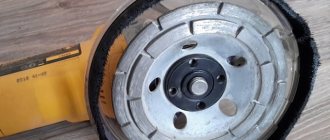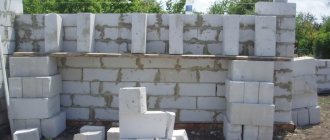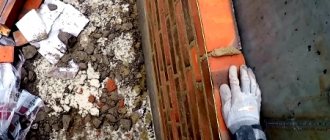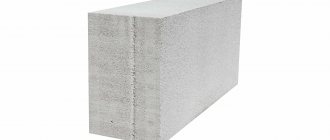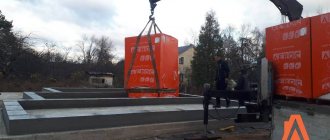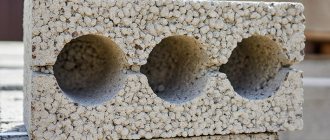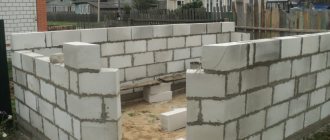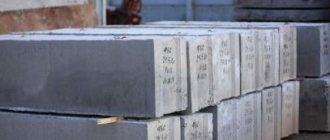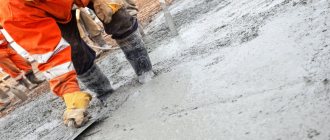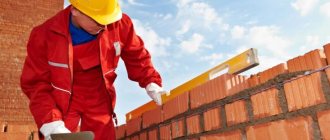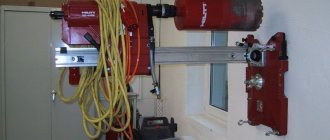Features of the use of materials
Foam concrete is cellular concrete obtained through the hardening process of a solution that contains cement, sand, water and foam. Foam blocks are a hardened mixture of binder, siliceous component and air cells that are formed due to the action of foaming agents. It is the latter component that ensures uniform distribution of air in the blocks. They are considered lightweight, warm structural building products. They burn very poorly and protect other materials from fire. Houses made of foam blocks will be warm and reliable, and during operation they will allow you to save on heating the building. It is important that their thermal conductivity and volumetric weight are several times lower than that of sand-lime brick.
Foreman's advice
: for laying load-bearing walls (internal and external), partitions of low-rise buildings, it is better to use foam blocks with a density of at least 500-500 kg/m³.
Cinder blocks are made from cement, sand, water and a special filler (usually blast furnace slag or expanded clay chips). They have good technical characteristics, but some significant disadvantages require a special approach to their use during construction. The owner needs to take care of high-quality waterproofing, insulation of walls and roof. But this material is cheaper and easy to install (even a non-professional can do it). needs careful finishing of internal walls. First, a wooden sheathing is attached to the surface, then insulation, foil and, at the final stage, wooden upholstery.
Cinder blocks are made from cement, sand, water and a special filler (usually blast furnace slag or expanded clay chips). They have good technical characteristics, but some significant disadvantages require a special approach to their use during construction.
Foam blocks
Foam blocks are made by foaming concrete using special installations. The quality of the foam block is practically in no way inferior to brick. And the biggest advantage is the cost of the blocks. It is much lower than a brick. But, despite the fact that foam concrete is very similar to brick, it also has its positive and negative sides.
Pros of foam block
- Foam block is an environmentally friendly product that does not harm people. It is made almost entirely from natural materials: sand, cement and foaming agent.
- Fire-resistant and responds well to possible temperature changes.
- Foam block walls do not require additional insulation.
- The low weight of the foam block will allow you to install a foundation and drive out walls on not very stable ground. It is easier to work with, which means the time spent on construction is reduced.
- Compared to a cinder block, communication in a foam block is quite easy.
- It has a very high level of sound insulation, so it can be used not only for interior walls.
Disadvantages of foam block
- Improper technology in the production of foam blocks can affect the quality of the product itself. The blocks will break and crumble a lot.
- Just like the gas block, it does not like moisture; lack of ventilation, as a result, can collapse.
All the shortcomings of the foam block can be easily and quite simply eliminated. And in order to protect yourself from low-quality products, you need to buy blocks from trusted manufacturers. Also, the facade wall can be protected from moisture if the facade is finished with heat-insulating material.
Comparative characteristics of foam concrete and cinder block
Foam and cinder blocks have different technical characteristics and design capabilities. But if you follow the construction technology and choose the right product according to its characteristics, the selected building material will perform its task efficiently. Foam block has better properties, but it costs significantly more. Cinder block is cheaper, but has some disadvantages that need to be compensated for by good thermal and waterproofing. The choice should depend on the financial capabilities of the construction site owner and housing requirements.
Video
Cinder blocks and foam blocks are successfully used in the construction of buildings for various purposes. The widespread practice of using both materials does not negate the fact that the characteristics of these blocks are not known to everyone. If we draw a parallel between a brick and a wooden structure, then the future owner of the building will easily be able to make a choice in favor of one or another option, taking into account his own requirements and the purpose of the structure being built.
The situation is completely different when it comes to blocks. The similarity of shape gives many people the erroneous impression that these two materials are practically identical. And to answer the question as to which is better: a cinder block or a foam block, it is necessary to consider the characteristics of each. If you know all the pros and cons of these blocks, conduct a comparative analysis, and make a choice in favor of one option or another, it will not be difficult.
Foam block and cinder block
They are structural building materials produced in the form of blocks, but having a distinctive composition and production technology:
- Cinder blocks. This artificial building material is produced both in factories and at home. Coal slag, broken bricks, rock screenings and stone crushing are used as the main filler, and cement is used as a binder. Manufacturing is carried out using installations that differ in design and principle of operation, which allows the formation of blocks of various sizes and densities.
- Foam blocks. They are a porous structural material consisting of cellular lightweight concrete formed using the foaming method. It also contains sand with water and cement, and porosity is achieved through the use of foaming agents. The process of mixing and distributing foam is carried out in stationary or mobile installations.
Both foam block and cinder block are structural building materials, but with different composition and production technology, which is reflected in the physical and operational properties.
Foam block and cinder block - comparison
Aerated concrete has recently become popular in construction; cinder blocks have been used by builders for a long time to construct objects. The popularity of aerated concrete was influenced by its low cost, global crisis, and availability for any developer.
Cinder blocks began to be used en masse from 1927 to 1930. This was the time of industrialization in the country. When they began to smelt steel and cast iron in large quantities. The resulting slag was considered waste material and had to be used.
Even today we sometimes see old buildings built using cinder blocks (see). In those days, the material was attracted by its low cost and ease of manufacture. This was important! The country was rising!
What are the benefits of a block structure? After all, it has its own advantages and disadvantages, they must be studied before making a decision.
So:
- First of all, this is the speed of construction
, because the blocks are larger than bricks and the work can be done quite quickly. - So does thermal insulation.
There are of course some differences here, but overall it’s excellent. - By doing the work yourself, you can significantly reduce costs.
After all, face masonry is not done here.
Attention: The main disadvantage of the blocks is the mandatory cladding. It's just not a face material. And therefore, when deciding whether cinder blocks or foam blocks are better, you should immediately include the cost of finishing.
Foam blocks or cinder blocks, which is better depends on the parameters of the material. The characteristics that are important here are, first of all, they are different. Let’s go straight to them and look at cinder blocks or foam blocks, which is better in terms of their performance.
Manufacturing of gas blocks
A new technology is used for production - foaming.
So:
- It consists of cement, sand and water. The composition is foamed and poured into molds, where the products harden. Become suitable for construction. The internal component is a large number of microscopic air bubbles. They give the product lightness.
- Therefore, the products do not allow moisture to pass through easily and do not sink in water. They have enhanced waterproofing. The blocks do not require additional protection - this is a positive quality that is highly valued by developers. For them, this is a profitable material!
- It almost does not allow heat to pass through, which indicates energy saving. As a result, in winter you can save on heating costs. Building an object from blocks is a pleasure and an attraction for any developers. Walls are built from it quickly. Organizers do not need to carry heavy products. The walls can be laid out in one row, the house will still be warm. There is no need to involve a lot of people to carry out the construction process. The construction option is one of the most profitable and has become available to many since the invention of the product.
- Due to the lightness of the material, there is no need to build a complex foundation. Even a lightweight foundation will do, because the weight of the building will still be light. Work on its installation is carried out without the use of specialized equipment. The result is a reduction in costs for the facility, a benefit for the developer.
If the blocks are not counterfeit, then their index reaches 99%. Therefore, it is sometimes compared to a tree. The porous structure of the blocks allows the building to breathe.
As it happens in a wooden house. Therefore, the buildings have a good microclimate.
They are easy to cut, creating objects of unusual shape during construction. The design solution for the facility can be anything, taking into account the customer’s requirements.
| Advantages | For any developer, the cost and strength of the material are the deciding factors when purchasing. The advantages of the material also include:
|
| Flaws | This material has flaws, just like bricks. The main one is water absorption. Therefore, even after the completion of the construction process, moisture may be observed in the house. The house should be thoroughly dried before use. In winter, the external structure of the house may become covered with ice. This reduces the heat in the house. |
Cinder blocks - production
Cinder block has been popular since ancient times. Cheap product for the construction of objects.
- In its manufacture, components are used - cement of a certain brand, slag, ash. The filler for the materials is a sand-gravel mixture, granite screenings, stones, crushed stone, sawdust, gravel, sand, and other types of waste.
- The sizes of the blocks and weight are different. Specialists do not comply with standardization during production. Many firms, entrepreneurs, and developers of personal estates are now involved in the production of the product.
- The low thermal conductivity of products is incomparable with bricks. It depends on the type of fillers used to create the compositions. The highest quality and most durable products contain lime in their composition. These products are used by many for construction.
| Among the advantages |
|
| Disadvantages of cinder block | Like all materials, it has disadvantages. Among them:
|
Aerated blocks in construction - Multi-storey buildings are not built from aerated blocks. Although it doesn't have many shortcomings. But even those that exist are alarming to developers. Among them is the low strength of the blocks. This is critical. Then developers use a mixed type of masonry, where brick is interspersed with aerated concrete.
Cinder blocks in construction - Cinder blocks are used not only in the construction of walls. It is used for laying foundations. Then the blocks are made from a concrete mixture and a certain filler. The choice depends on the preference of the developer and the strength of the material being created.
What are the benefits of cinder block?
The use of construction waste has endowed cinder block with one significant advantage that contributes to its widespread use in the field of construction - low cost. There are no clear restrictions on the slag involved in the production process, which allows you to use almost any waste remaining on the construction site.
Cheapness is not the only advantage of the material. The advantages of cinder block include the following characteristics:
- fire and frost resistance, good thermal insulation;
- large sizes for easy transportation and stowage;
- possibility of production at home (garage) conditions;
- small specific gravity, practically independent of the dimensions of the block.
Cinder blocks are not affected by fungus or mold. They do not harbor bactericidal bacteria, pests and insects. They do not require the construction of complex foundations. This leads to a reduction in the cost of erecting one-story buildings and utility rooms.
What are the disadvantages of cinder block?
The use of waste has made cinder block one of the most affordable building materials, but also endowed it with certain disadvantages that the developer should be aware of:
- Fragility. Finished buildings are durable, but the blocks themselves, unfortunately, are quite easy to damage. They must be handled with the utmost care, protecting them from direct mechanical impact.
- Instability to moisture. Constant exposure to water and precipitation leads to a sharp reduction in the service life of building materials. Premature destruction can be avoided by plastering and installing waterproofing.
- Low environmental friendliness. This disadvantage is due to the use of waste materials in production. And if the developer focuses exclusively on the construction of modern and environmentally friendly houses, cinder block is not the best choice.
Blocks made from slag do not have good sound insulation and have a rather unpresentable appearance. Buildings erected from it require high-quality interior and exterior finishing. Laying communication systems is associated with certain difficulties.
cinder block
Cinder block is not a new material in the construction field. It has been tested for decades, and that is why people are not afraid to buy it and build houses from it. In any more or less large populated area you can find a cinder block manufacturer; everything has been clear and understandable with production technology for a long time - a lot of experiments have been carried out, which have been tested in practice and have given certain results that allow us to draw conclusions.
The first thing that catches your eye is the fairly low price of the material; it is directly related to the fact that recycled material – slag – is used in the production of the blocks. The block is also made from a concrete mixture and various fillers, so it will be somewhat lighter than brick. The weight and size of each block may not be the same, since GOST standards do not have cinder blocks. Such material can be produced not only in factories, but also in private firms, which again does not make it possible to unambiguously judge the quality of the material.
Another distinctive feature of cinder block is its low thermal conductivity when compared with brick or foam block. But here, too, the developers found a way out. They improved thermal conductivity using various fillers. Therefore, if you need more heat-conducting materials, pay attention to the composition of the cinder block.
Many experts who have worked with such blocks recommend cinder blocks with lime admixtures, as they are more durable. And few people know that cinder blocks can be used not only to build walls, but also to lay a solid foundation.
Pros of cinder block
- One of the most important advantages is speed and ease of use. A cinder block is the size of approximately 7 bricks, so it only takes a couple of hours to lay out the wall.
- Due to its low thermal conductivity, cinder block is a good thermal insulation material.
- A wall built with cinder blocks dries much faster than with other materials.
- Cinder block is not dangerous to human health, as it is completely non-toxic, does not contain radioactive substances, and is fire resistant.
Although, of course, it would not be superfluous to check the documents with a sanitary and hygienic certificate for the purchased batch of material. Radiation is a relative indicator.
Cons of cinder block
- Has a very low level of sound insulation. Therefore, it is still better to use cinder blocks for walls inside a residential building. If you live near a busy road or are building an apartment building for several residents, after a short period of time you will most likely want to soundproof the walls, and this is a troublesome and expensive pleasure.
- After the construction of the walls is completed, it will be necessary to do the interior and exterior decoration, since externally the cinder block is not distinguished by its elegance and attractiveness.
- Cinder blocks are very afraid of water and moisture, so walls can collapse relatively quickly in our climatic conditions. This can only be avoided by substantially working out the elements of waterproofing and vapor barrier of the walls, both on the outside and on the inside of the building.
- The heavy weight of a cinder block wall requires a reliable foundation. It is not recommended to use such material for multi-storey construction, as there is a high risk of cracking of the walls and foundation.
- Cinder block makes it difficult to install internal communications wiring. It is not very easy to work with; it requires considerable physical strength both for transportation and for laying walls. Even if it is possible to work with cinder blocks on your own, it is definitely problematic.
If you still choose cinder block material, do not forget that after using it you will need to cover the outside of the house with brick or, for example, siding. And this will lead to some waste.
Where is cinder block used?
If the developer plans to produce this material independently, he can completely control the entire process, which makes it possible to obtain good quality blocks. When products are purchased from a third-party manufacturer, it is necessary to check all documents and certificates of conformity. Otherwise, the likelihood of purchasing material with low characteristics increases sharply. You can build a good house from high-quality cinder block, but only if you carry out good hydro- and sound insulation, as well as façade cladding and interior decoration. This will easily eliminate almost all the shortcomings, but will not increase the environmental friendliness. Household and household buildings made from it are much cheaper than those made from other materials, and they do not need finishing.
What are the advantages of foam block?
The blocks made from lightweight cellular concrete differ from cinder blocks, possessing qualities that the latter lacks. Foam blocks have the following advantages:
- Increased waterproofing properties. Low absorbent properties appear even when the material is placed in water. A foam block in liquid does not sink. Therefore, no additional waterproofing is required.
- Excellent energy saving qualities. This figure is 3-4 times higher than that of a cinder block. Building a house from foam blocks allows you to significantly save on insulation and heating.
- Light weight and low load on the base. Like cinder block, foam block does not require the construction of an expensive foundation using special equipment.
- Ecological cleanliness. The environmental friendliness index of the foam block is approximately 99%, which allows us to compare this material with natural ones. Thanks to its porous structure, buildings made from it “breathe.”
The only point regarding the purchase of foam blocks is careful attention to the choice of supplier in order to exclude the purchase of counterfeit products of dubious quality.
Differences in how materials are produced
To choose the most suitable building material, you need to familiarize yourself with all its features in advance. Aerated concrete differs in its properties from expanded clay concrete. Walls, load-bearing and internal partitions of houses are often built from these materials.
Expanded clay block is used in construction as a monolithic material. Hollow and solid expanded clay concrete is offered on the market. The use of aerated concrete in monolithic structures is rarely used. Produced gas blocks can vary in size.
The composition and production technology of these materials are very different, but both of them belong to the class of cellular concrete. Aerated concrete is a porous material containing a huge amount of air bubbles. The raw materials used for its production differ from the materials from which expanded clay concrete is made.
Aerated blocks are made from the following types of materials:
- sand;
- cement;
- lime;
- aluminum powder.
The process of the appearance of air bubbles associated with gas formation involves the use of aluminum powder. As a result, the produced building material is porous. Aerated concrete, like expanded clay concrete, is produced under a certain brand.
The production of expanded clay concrete is carried out from the following types of materials:
- sand;
- cement;
- expanded clay;
- water.
During the manufacturing process, the entire mixture is mixed, and water is used as a binder. Expanded clay can have different fractions. The technology for manufacturing expanded clay concrete does not require the use of special equipment. Unlike aerated concrete blocks, expanded clay concrete can be made at home.
What are the disadvantages of foam blocks?
Blocks made from lightweight cellular concrete also have some disadvantages. They are few in number, but quite significant:
- The need to comply with masonry rules. If the blocks are laid using a thick layer of binder, then thermal insulation is reduced to a minimum. To avoid this, you should use special glue rather than cement mortar.
- Low strength. The material requires careful handling. It is not recommended to hang expensive and heavy equipment on foam block walls. To calculate the maximum load, you should contact a specialist in advance.
- Possibility of acquiring counterfeit goods. There are inexpensive analogues that unscrupulous sellers pass off as high-quality foam blocks. It is produced using synthetic blowing agents and has low environmental friendliness.
Laying foam blocks is simple, but requires preliminary sanding and processing. Violation of technology, a thick masonry layer, and the purchase of counterfeit products reduce to zero all the advantages that this block material has.
Disadvantages of foam block
- It was stated above that foam concrete has good thermal insulation properties. However, these properties can only manifest themselves with proper laying with a minimum thickness of the binder material. It is usually better to use special glue for such purposes. But often, in order to save money, builders use cement mortars, which reduce the thermal insulation of the room to a minimum;
- All the simplicity in work lies only in laying the blocks. However, before construction begins, each block must be thoroughly cleaned, sanded, and polished. If the processing technique is violated, negative consequences may occur. In addition, unlike the high-tech production of aerated concrete, foam concrete is often made in artisanal conditions, which does not protect the buyer from low-quality goods;
- Installation of various types of fasteners is easy. However, they can just as easily get out. Therefore, hanging expensive equipment on a foam concrete wall, alas, is unsafe;
- The material, like aerated concrete, is light and therefore fragile. When building a house, it is better to seek advice from a specialist who will calculate the permissible weight of additional elements laid on the foam block.
Area of application of foam block
The porous structure of the material ensures ease of processing. This allows you to cut blocks, giving the elements different shapes, which makes it possible to translate even the most elaborate and intricate projects into reality. The cost of a foam block is slightly higher than that of a cinder block. It is excellent for the construction of both residential and commercial buildings. It fits into one block, the parameters of which are twenty times greater than those of a standard brick. However, given the not the highest strength, in multi-story construction this material is used exclusively in combination with others. This requires an expensive project and accurate load calculations.
What to prefer for construction?
If we compare the benefits of using foam blocks or cinder blocks, then the latter get the advantage. Cinder blocks are cheaper . This, in fact, is their main advantage.
These two artificial stones are similar in their properties. However, it should be borne in mind that a standard cinder block replaces 4-5 bricks during installation, and a foam block 7-8. Cinder block has more weight and is inferior to foam concrete in terms of thermal insulation properties. The strength of a foam block of the same brand is higher than that of a cinder block, and it is not affected by the environment. Foam blocks are also called eco blocks because of their absolute safety for humans. In addition, foam concrete can be used for thermal insulation.
In conclusion, it should be noted that it is better to purchase finished products that are produced in accordance with GOST, rather than using homemade foam and cinder blocks. Both of these materials, if they are of the appropriate grades, are suitable for any stage of construction, from laying the foundation to erecting load-bearing structures of both residential buildings and commercial buildings. Which of these materials is suitable is up to you to decide.
Cinder block or foam block - which material is better?
It is impossible to answer this question unequivocally. For the construction of residential buildings in regions with harsh winters and humid climates, foam blocks are an ideal solution. Cinder block can also be an excellent inexpensive alternative, but only in moderate weather conditions. Otherwise, the need for expensive insulation and good waterproofing will minimize cost savings. Considering the low environmental friendliness of cinder block, this material is not the best choice for residential buildings. It is recommended to be used for domestic and commercial buildings.
The abundance of building materials on the modern market is often confusing. What to choose for the construction of walls of individual construction or industrial buildings? The range of products is quite wide, but what is hidden behind the name and what type of building material should you prefer? Our article examines the difference between two fairly popular types: foam block and cinder block. Our article will tell you what the difference is and which material will be preferable.
To make a foam block, a certain composition is used, the main components of which are cement, sand and a special foaming agent. Thanks to this, the structure of the blocks becomes as if saturated with air bubbles - pores. This innovation has shown itself to be excellent, because thanks to the air pores, the material acquires additional heat capacity.
Advantages of using foam blocks:
- Strength.
- Resistance to temperature changes.
- Affordable price.
- Durability of construction.
- Possibility of trouble-free installation of communications.
- There is no need for additional insulation outside.
In the video - making a foam block:
A big advantage when choosing foam blocks will be the ability to produce slabs of various sizes directly on the construction site. To do this, you can use wooden formwork or special forms. The dimensional accuracy will not be too high, but transportation costs will be reduced.
Among the disadvantages, it should be noted the rather significant consumption of the fastening composition, which is not always advisable. Also, foam blocks are quite massive and require additional labor, which, however, is typical for most building materials of this kind.
Foam block production
To make a foam block, a certain composition is used, the main components of which are cement, sand and a special foaming agent. Thanks to this, the structure of the blocks becomes as if saturated with air bubbles - pores. This innovation has shown itself to be excellent, because thanks to the air pores, the material acquires additional heat capacity.
Advantages of using foam blocks:
- Strength.
- Resistance to temperature changes.
- Affordable price.
- Durability of construction.
- Possibility of trouble-free installation of communications.
- There is no need for additional insulation outside.
The video shows how to make a foam block:
A big advantage when choosing foam blocks will be the ability to produce slabs of various sizes directly on the construction site. To do this, you can use wooden formwork or special forms. The dimensional accuracy will not be too high, but transportation costs will be reduced.
Among the disadvantages, it should be noted the rather significant consumption of the fastening composition, which is not always advisable. Also, foam blocks are quite massive and require additional labor, which, however, is typical for most building materials of this kind. Therefore, it is impossible to answer unequivocally.
Making cinder block
Among the disadvantages, it should be noted the rather significant consumption of the fastening composition, which is not always advisable. Also, foam blocks are quite massive and require additional labor, which, however, is typical for most building materials of this kind.
The production of cinder blocks involves the use of special vibration-pressing machines. Cement mortar is poured into the prepared forms, into which slag, combustion waste and ash are added to provide additional characteristics. You can often find cinder blocks with the addition of stone, granite, crushed stone screenings and other inclusions.
Advantages of cinder blocks during construction:
- Affordable price.
- Possibility of self-production.
- Moisture resistance.
- Different compositions of components give the material altered characteristics.
The physical properties of this material directly depend on the raw materials used in production, so it will be difficult to give an accurate description. Typically, “heavy” and “light” blocks are classified, which contain various grades of cement.
In the photo - a cinder block house:
“Heavy” cinder blocks are used mainly for the construction of basement floors and when laying foundations. The “light” variety of material is used for the construction of walls. A feature of construction from this material can also be called various additives, thanks to which the blocks acquire additional properties. The pros and cons of cinder block houses are described in detail. You can see the sizes and prices of cinder blocks.
In the video - making a cinder block:
Several nuances of using different compositions
- Adding large slag will increase thermal conductivity and make the material more porous and lighter.
- Selected small slag will make the block heavier. Typically, this type is not used in the construction of residential premises due to the high thermal conductivity of the structure.
- Often small sawdust is added to the composition. This makes the blocks look "cleaner" and is often used for residential use. The downside is the need for additional waterproofing, which increases the cost of exterior finishing of the building.
The versatility of this version of the building material is difficult to overestimate, but at the same time it will also have significant disadvantages. Many manufacturers add unsuitable substances to the composition, the purity and safety of which raise serious concerns.
Also, this material is not very suitable for individual construction due to its good thermal conductivity, which will increase the cost of heating the building. External insulation can partially cope with the problem, but it will not help completely eliminate it. Cinder blocks are more suitable for the construction of utility rooms and industrial buildings.
This will significantly save the cost estimate and give the structure the specified parameters.
Brick or expanded clay concrete blocks?
Expanded clay concrete blocks are a highly porous building material consisting of natural materials: sand, expanded clay (burnt clay) and cement. Due to their distinctive properties, these expanded clay blocks are successfully used for thermal insulation of buildings of any number of storeys, as well as in the construction of load-bearing and internal walls of residential and commercial buildings, in this regard providing significant competition to traditional brick and reinforced concrete slabs. Advantages and disadvantages of building bricks Advantages: • high margin of mechanical strength, allowing the use of brick as the main material in high-rise and industrial construction with critical load values; • absolute fire safety; • environmental and antiseptic cleanliness; • invulnerability to atmospheric and negative chemical influences; • long service life. Negative qualities: • relatively high price; • insufficient level of thermal insulation; • low quality of sound absorption; • poor waterproofing; • the possibility of mechanical fracture due to impact. Pros and cons of expanded clay concrete blocks Advantages: a house made of expanded clay concrete blocks. • significantly lower weight of the same volume than brick. In practice, a concrete block of the same size is almost 100% heavier than expanded clay concrete, and the dimensions of one standard such block correspond to laying more than 20 bricks; • due to the above-mentioned properties, the blocks in question are distinguished by relatively lower transportation costs, and their installation is less labor intensive; • the thermal insulation coefficient of the blocks is 300% higher than that of standard brick and 600% higher than that of concrete. A standard 39 cm thick expanded clay concrete block retains heat in the same way as 60 cm of brickwork; • noise reduction performance improved 10 times compared to brick, that is, almost optimal sound insulation in urban conditions; • environmental safety no less than that of brick; • high fire resistance and no danger of burning; • good (almost like wooden buildings) air permeability and ensuring an optimal microclimate in the room; • ease of mechanical processing of the material and giving the block any shape. • lower cost than standard bricks and conventional concrete blocks, due to the peculiarities of production on vibrating machines
Thus, when constructing buildings up to 3 floors, the analyzed blocks will be the best option for the external walls of buildings, mainly in areas with a small amount of annual precipitation; in any area and for any building, this material is optimal for internal thermal insulation of external and construction of internal walls. Finally, another very significant, and often priority, advantage of using blocks is the possibility and comparative simplicity of independent construction of buildings and structures. Features of self-assembly: expanded clay concrete blocks brick Despite the light weight of the blocks compared to traditional building materials, the foundation for the building must be solid and reliable, preferably a strip foundation. Therefore, as with the construction of brick buildings, the foundation can be monolithic reinforced concrete, as well as strip or columnar on appropriate foundations. Expanded clay concrete blocks are placed on a traditional cement-sand mixture. It is important that each subsequent block is checked for tightness on a dry surface: identified irregularities can be immediately removed with a regular hacksaw with alloy metal pads. Otherwise, the construction of the structure is carried out using conventional technologies using traditional construction measuring tools.
All prices for expanded clay concrete blocks are here
What's better
No one can give a knowingly correct answer. If we look at the issue from several angles, foam blocks have more advantages in using them. However, the popularity of the second material is also beyond doubt. If we consider what is cheaper, then the cost of finished cinder blocks is an order of magnitude less, which often becomes a priority when choosing a suitable material.
Having compared the technical characteristics, it is also impossible to come to an unambiguous conclusion; some heat losses inherent in cinder block material also apply to foam blocks to one degree or another, so it would not hurt to perform external insulation for this material as well.
To summarize, we can say with confidence that for the construction of residential buildings it is preferable to use foam blocks due to the low thermal conductivity of the material. It is better to use cinder block for the construction of utility and industrial facilities, for which this indicator will not be so important. The option of using a combined composition of materials is allowed: to lay the foundation and basement floor, use cinder block as a cheaper and stronger material, and use foam blocks when constructing walls.
The video explains which is better: foam block or cinder block:
The most important task after deciding to build a house is the choice of building materials. And you need to choose whether a foam block or a cinder block is better at the stage when the house is still under construction. This decision will determine the characteristics of the finished structure, environmental parameters and operational life. Both materials have been on the construction market for quite a long time and are quite widely known. They are similar in some ways, but they also have a lot of differences. You need to consider the main characteristics and make a comparison: which is cheaper and better?
Which is better in terms of basic parameters, cinder block or foam block
| Parameter | Comparative characteristics |
| Resistance to temperature changes | Both materials are resistant to high temperatures. As for frost resistance, cinder block does not perform well here. |
| Price | A cubic meter of cinder block will cost much less than a cubic meter of foam block. |
| Moisture resistance | Cinder block is susceptible to destruction when exposed to moisture. The foam block is not subject to direct destruction from water, but its indirect influence can destroy it. Therefore, buildings made from both materials should be thoroughly waterproofed. |
| Weight | The density and, accordingly, the weight of the foam block is much lower; it is easier to work with it than with a cinder block. |
| Strength/Durability | Both materials have high strength, but the foam block is more fragile. Also, due to the relative novelty of this material, there is no practical data on its durability, while cinder block has already proven itself to be the best in this regard. |
| Thermal conductivity | According to this indicator, the clear leader is the foam block. Due to the large number of pores filled with air, it has high thermal insulation qualities, whereas this is a weak point for cinder block. |
| Environmental friendliness | In this regard, it is also better to prefer a foam block, since contact with a cinder block can lead to allergic reactions and respiratory diseases in some people. |
Foam block, as a more modern material, has slightly better performance characteristics and a correspondingly higher price. In addition, costs may increase due to damage during transportation or careless handling. So the answer to the question of which is preferable, a foam block or a cinder block, will depend on personal preferences and specific conditions. However, if the budget allocated for construction allows, then in most cases the foam block will be a better choice.
Characteristics of cinder block
Slag concrete was closely associated with Soviet metallurgy. It was from the waste remaining in large quantities during the production of various metals that this building material was made. Its main component was blast furnace slag. Now it is successfully replaced by various components:
- combustion products - ash and slag;
- small crushed stones and crushed stones;
- brick fight;
- sawdust;
- expanded clay;
- perlite
Instead of slag, all kinds of waste are used. This explains the cheapness of the blocks. The dry components (cement and filler) are mixed, then water is added. After obtaining a homogeneous consistency, the composition is poured into pre-lubricated molds and placed on vibrating equipment for compaction. The forms are left to stand under normal conditions for several days. It is possible to use fresh cinder blocks immediately for construction, but cement gains strength over the course of a month, so it is better to wait.
The benefits include:
- good thermal insulation properties;
- ease of construction due to the large size of the blocks (5 times larger than bricks);
- moisture resistance;
- non-flammability;
- strength;
- frost resistance.
The disadvantages are:
- poor sound insulation;
- external and internal finishing is required;
- fragility;
- strong exposure to water, mandatory waterproofing is required;
- It is not recommended to build houses higher than 3 floors;
- questionable environmental friendliness.
The characteristics of the physical properties of cinder blocks are determined by the raw materials used for their production. They can be very different. It is difficult to compare them with each other. Conventionally, they are divided into light and heavy. Heavy ones have higher strength characteristics and are used in the construction of foundations and basement floors. The lungs are used to build walls.
Cinder blocks in construction
Before answering the question of which material is better, you should fully understand the advantages and disadvantages of cinder block.
They will help you make the right decision when choosing.
Cinder blocks are used not only in the construction of walls, but also for laying the foundation.
Its low cost is explained by the use of waste materials in production. The blocks are made of concrete mixture with the addition of the necessary fillers. The weight and dimensions of the block may vary slightly. Here the standards are not met, since production is carried out not only by enterprises, but also by private entrepreneurs. A distinctive feature of cinder block is its low thermal conductivity in comparison with. But thermal conductivity also depends on the filler, so when choosing, you should pay attention to its composition. According to experts, cinder blocks made of lime are considered the most durable.
The advantages of cinder block include:
- the main positive quality is ease of construction, namely speed: a cinder block is 7 times larger than a brick, so laying a wall will take only a few hours;
- due to their low thermal conductivity, cinder blocks have good thermal insulation;
- the finished wall, made of cinder blocks, dries quickly;
- the material is non-toxic and safe for health.
This material has disadvantages:
- low level of sound insulation;
- after construction is completed, external and internal finishing will have to be carried out;
- makes it difficult to conduct internal communications;
- cinder blocks are afraid of water; under frequent exposure to it, the service life of the blocks is noticeably reduced.
When giving preference to the described material, it should be borne in mind that it may be necessary to cover the external walls with brick, and this leads to additional financial costs.
Return to contents
